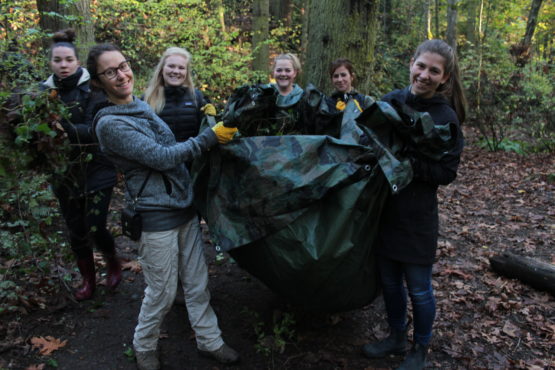B.C.’s biggest environmental volunteer organization partners with UVic’s Campus Planning and Sustainability office

The Greater Victoria Green Team. Photo by Carina Pogoler, Senior Staff Editorial Assistant.
On Nov. 14, the Greater Victoria Green Team (GVGT) will host middle school students from Claremont Secondary and Oak and Orca Bioregional School to remove invasive species in Mystic Vale.
All members of the UVic community who are interested in doing something positive for the environment are welcome to join.
The event is part of a pilot project recently launched by the GVGT and UVic’s Campus Planning and Sustainability (CPS) office, in partnership with UVic Facilities Management, the Restoration of Natural Systems program, and the Environmental Restoration Volunteer Network.
The program will consist of six environmental activities in Mystic Vale during this school year.
The goal is to “increase campus biodiversity by reducing the number of invasive species,” as well as to involve students in the ongoing care of habitat on campus, said Mathew Greeno, Sustainability Coordinator of CPS.
Amanda Evans, Program Manager of the GVGT, hopes that the event will draw in a diverse crowd.
“Environmental Studies classes [often] engage in these types of activities, but we’re really hoping to reach out to new classes that aren’t just environmental, like business, education, computer science, law … there’s lots of opportunities so we’re really hoping to get different types of students to come out,” she said.
Since their foundation in 2014, the GVGT has held around 250 environmental activities, engaging approximately 5 000 volunteers. The GVGT is a branch of Green Teams of Canada, a national charity, and was started after the success of the Lower Mainland Green Team in Metro Vancouver. Together they are B.C.’s largest environmental volunteer organization.
You get a lot of people who feel isolated and helpless, wishing they could do something to help the environment, but don’t know how.
The GVGT works with volunteers to build trails, clean shorelines, plant native species and remove invasive ones. But that’s not all they do.
“Though we’re considered an environmental organization, in that all of our activities are about the environment, we really are about the community,” Evans said. “Social issues [are] directly connected to what’s happening to the environment.”
Ironically, even though technology connects us today more than ever before, social isolation is an increasing problem. Combine this with the loads of bad news about the environment (such as the recent Intergovernmental Panel on Climate Change report, as covered in a previous editorial), and you get a lot of people who feel isolated and helpless, wishing they could do something to help the environment, but don’t know how.
The GVGT is tackling this issue by making their events accessible and fun, and making sure their volunteers feel appreciated.
“When people don’t feel connected to each other, they don’t [know] where to start in terms of helping the environment, so connecting and creating a welcoming, safe, and inclusive space for people to meet each other and do something good, it really creates [a] sense of hope and empowerment,” Evans said.
“If we are able to foster deep connections with nature in our young people, then they are more likely to grow into active adults who want to protect our natural world.”
From applying for grant funding to completing restoration projects, collaboration is a big part of the GVGT model.
“We’re trying to get over that thing of working in isolation … which often happens in the environmental [sector],” said Evans.
The GVGT collaborates with Parks staff from all levels of government, neighbourhood associations, and local universities to complete restoration projects. They are also taking a unique approach to grant applications, partnering with other environmental organizations to secure funding, then sharing the rewards.
“[With] the Green Team model we’re really venturing into new territory,” said Evans.
The GVGT recently collaborated with Jennifer Gruno, a sessional instructor and doctoral student at the School of Exercise Science, Physical, and Health Education, who took her class of future elementary school teachers to remove English Ivy from Mystic Vale on October 11.
“I was hoping that my education students would experience an activity … that they can mimic with their own students in the future,” said Gruno. “I feel nature based learning is incredibly important at all educational levels … If we are able to foster deep connections with nature in our young people, then they are more likely to grow into active adults who want to protect our natural world.”
If you’ve been wanting to do something to help the environment, the best place to start might be on campus.
Want to participate in the Ivy-pull in Mystic Vale on Nov.14? Register on Meetup.com/Greater-Victoria-Green-Team, where the GVGT post all of their events. Events for this year end in December and will start up again in February 2019.








